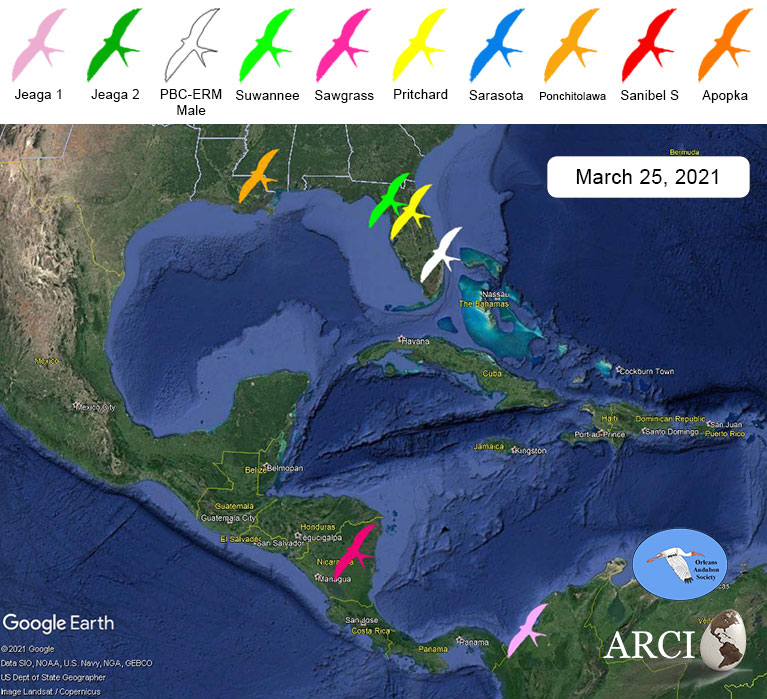The Avian Research and Conservation Institute (ARCI) currently tracks 10 Swallow-tailed Kites through their annual migration. These birds, each outfitted with GPS transmitters, are quickly making way back to their breeding locations in the Southeastern US.

Much has happened since our last update. Favorable winds have set kites a flight and across the Gulf of Mexico. Without pause, these birds have returned to their former nest sites of 2020.
First bird to make the trip was a Swallow-tailed Kite named PBC-ERM Male, from Palm Beach County, Florida was the first to head make the flight on 14 March.
Suwannee from the Lower Suwannee NWR in Levy County, FL was the next to leave the Yucatan Peninsula on 16 March followed by Ponchitolawa of Louisiana on 17March and Pritchard of Palmetto Bluff, SC on the 18th of March.
All GPS-tracked kites had a similar approach from the north shore of the Yucatan Peninsula of Mexico where they set off to the north across the Gulf of Mexico. Each landed on the Gulf Coast of Florida and then made their way to their 2020 territories. Pritchard is still progressing north through Florida on his way to South Carolina.
In the last week we received data uploads from two formerly “missing” birds due to their remote locations.
Sawgrass, from Pinellas County, Florida has made her way to Nicaragua.
Jeaga #1 from Palm Beach County, Florida is in northwest Colombia after crossing the Andes Mountains. Soon these two kites will be back in Florida too.
Apopka, a rehabilitated Swallow-tailed Kite from Orange County, FL has not uploaded data since the last week of January in Rondônia, Brazil. The battery expectancy of his transmitter may be coming to an end, but we are hopeful that he is OK.
Three other kites have been out of cell range for months; Sarasota last uploaded data from Acre, Brazil and both Sanibel South and Jeaga #2 last checked in from Colombia in the Fall.
Of course, as amazing as this remote tracking technology is, it remains imperfect. The timing of cellular-data uploads from kites on their winter range and during migration can be spotty due to a lack of cell coverage in remote areas. Kites sometimes go months without being in cell tower range to upload GPS location collected since the signal’s last transmission.
Wishing a safe migration to all Swallow-tailed Kites!
Audubon Center for Birds of Prey
bioGraphic
Caloosa Bird Club
Clearwater Audubon Society
CROW – Clinic for the Rehabilitation of Wildlife, Inc.
Florida Panther National Wildlife Refuge
Friends of Palmetto Bluff Conservancy
Friends of the Carlton Reserve
Friends of the Florida Panther Refuge
Friends of the Lower Suwannee & Cedar Keys National Wildlife Refuges
Halifax River Audubon
Jacksonville Zoo and Garden
Lower Suwannee National Wildlife Refuge
National Audubon Society
Oklawaha Valley Audubon Society
Orange Audubon Society
Orleans Audubon Society
Palm Beach County Department of Environmental Resources Management
Palm Beach Zoo and Conservation Society
Palmetto Bluff Conservancy
Peace River Audubon Society
Sanibel-Captiva Audubon Society
Sanibel-Captiva Conservation Foundation SCCF
Sarasota Audubon Society
Seminole Audubon Society
St. Augustine Alligator Farm Zoological Park
St. Petersburg Audubon Society
Sunrise Wildlife Rehabilitation
The Avian Reconditioning Center for Birds of Prey
Venice Area Audubon Society
West Volusia Audubon

We prescribe burned on big branch marsh nwr on march 20 & 22. We had four swallowtail kites over our burns all day … they were so cool, flying at tree top height. Diving. Rolling, grabbing insects. Even the tree swallows were in on the smoke action. As the smoke cleared, the birds left.
New to GA. Will we have kites?